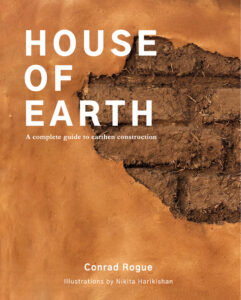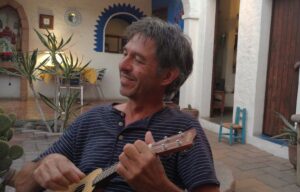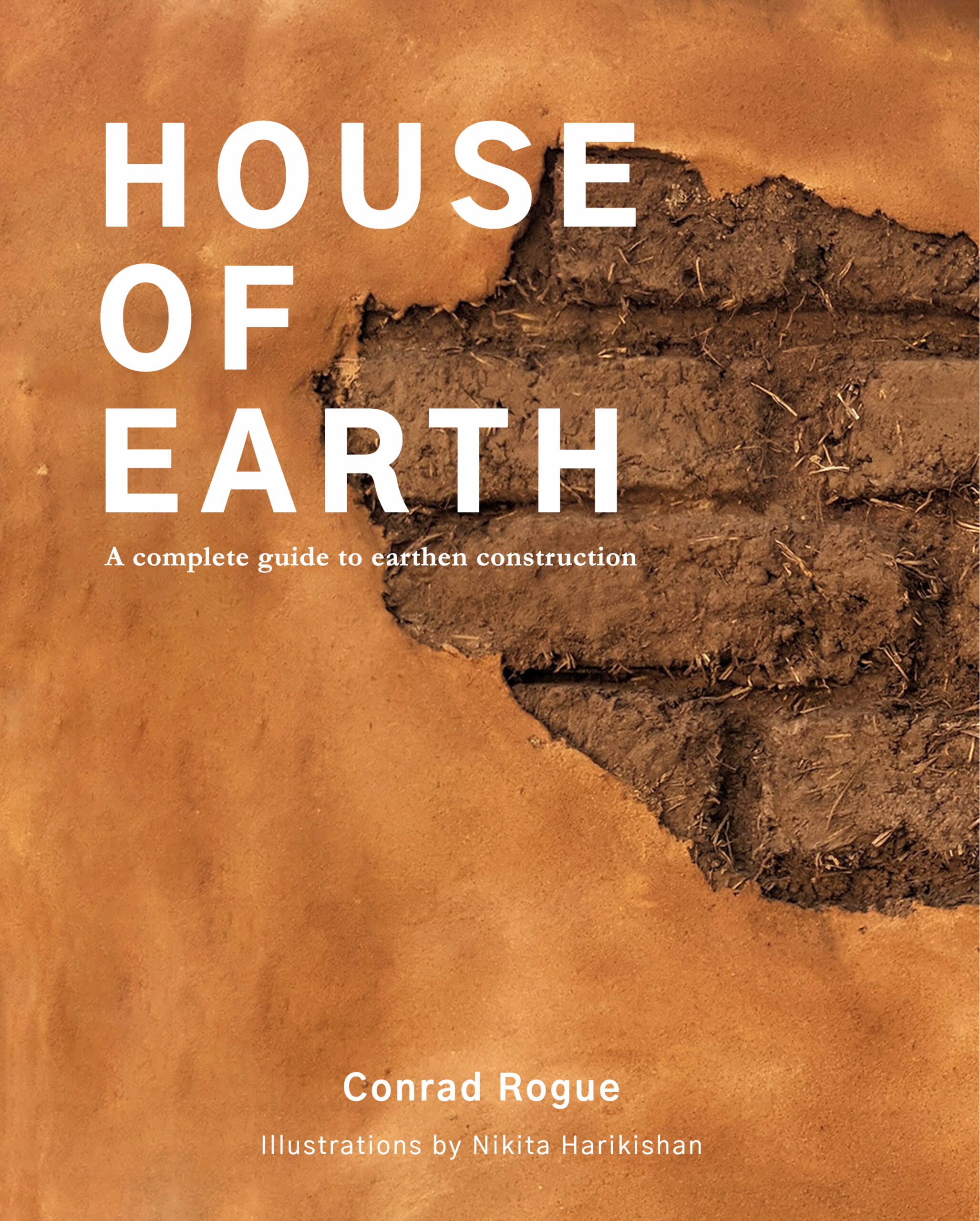Local builder, Conrad Rogue, shares the nitty-gritty on earthen construction

interview by Christina Ammon
Applegate Valley soil isn’t just good for farming; it’s also great for building houses. Longtime resident, Conrad Rogue, knows first-hand. Not only has he built several earthen structures around in the Applegate, but he’s also taught dozens of workshops around the world. Recently, he updated and reissued his book, House of Earth: A Complete Guide to Earthen Construction.
Below is an interview with Conrad about his book and about the benefits of building with natural materials.
CHRISTINA: Briefly summarize House of Earth.
CONRAD: The book is about how you can take three separate materials—clay, sand, and straw–and mix them together to build houses, walls, patios, pizza ovens, and finish them with earthen plasters and floors.
The book also explains what the materials are, how to find them, how to process them, and how to apply them to build just about anything
It’s a how-to book, but there’s about a dozen essays with a more philosophical slant–like how to deal with money, time, water, code and more.
CHRISTINA: What are the advantages of building with cob over conventional materials?
CONRAD: Most conventional buildings are extremely toxic because of all the foams, sprays, glues and paints that are used in them. These products are made faraway in places where they create a lot of damage to both the environment, plants, animal– as well as to the people who mine and process them. They are also very energy intensive and, by and large, expensive. Living with these materials can make you sick. And once the house is no longer useful, it becomes a waste problem.
Cob houses are more comfortable. Heavy earthen houses keep their temperature easily. They are comfortable in the winter and stay unbelievably cool in the summer.
Another thing: Earthen homes are standing on the ground and don’t have any hollow spaces either below the floor or in the walls. This makes it really hard for animals to move in and use your house as a habitat.
 Then there is the aesthetic quality. Thick walls, soft walls and colors and roundish shapes are all appealing. Also, it’s hard not to be irritated by a chip out of a conventional wall, but if you are in a cob house an imperfection like a crack, or a chip, often graces the building. I always say that conventional buildings deteriorate and earthen buildings age. Deterioration is very depressing—like a sinking ship. Aging can be done gracefully and with dignity.
Then there is the aesthetic quality. Thick walls, soft walls and colors and roundish shapes are all appealing. Also, it’s hard not to be irritated by a chip out of a conventional wall, but if you are in a cob house an imperfection like a crack, or a chip, often graces the building. I always say that conventional buildings deteriorate and earthen buildings age. Deterioration is very depressing—like a sinking ship. Aging can be done gracefully and with dignity.
CHRISTINA: Do you notice an increased interest in cob?
CONRAD: I think the whole housing situation in the world is very interesting at the moment. There’s a worldwide shortage of houses and housing prices have gone up a lot. In addition to that, there have been a lot more fires, energy prices are up, and building cost are up. In theory, there should be a lot more interest in ecological, affordable housing, but I’m not sure if that has really worked out in practice. I don’t think people are running for cob at this moment in time.
On the other hand, there’s been a group of people who have been trying to get cob into the building codes, and they seem to be making progress. I think this year cob is going to be in the code.
CHRISTINA: What would code approval do for cob building?
CONRAD: The good thing would be that cob builders wouldn’t have to hide anymore. On the other hand, once things get in the code, it may get so expensive and complicated that the people who are most  attracted to this style of building—people who want to be self-sufficient, ecological and cost effective–drop out. Only the wealthier folks who are ecological-minded or love the beauty of these houses will continue on doing so.
attracted to this style of building—people who want to be self-sufficient, ecological and cost effective–drop out. Only the wealthier folks who are ecological-minded or love the beauty of these houses will continue on doing so.
Having said so, earthen buildings have been around for more than 8000 years, so my guess is that they will continue on.
CHRISTINA: What are common misconceptions about cob building?
CONRAD: That it’s going to be cheap and easy. It can be cheap and it can be easy. But it can also be complicated, and it can be expensive. It all depends on how you approach it. You can take a little wooden cabin and do It cheap and easy, or you can do it expensive and complicated.

Conrad Rogue describes learning to build with cob to learning a musical instrument; both are very tactile experiences.
Cob lends itself well for building in community because there’s a lot of labor, but it’s fairly easy. In the matter of an hour, you can train a group of people to mix cob and start building walls, so in that sense it’s a great building method to do with a group of novices.
Another misconception that’s very common is that they won’t last in wet climates, or don’t do well in cold climates. In fact, they do really well in cold climates and don’t get washed away by the rain–even a little sideways rain on the wall is not going to disintegrate the buildings. A painted wooden building gets affected by sun and rain a lot more than a cob building, and the repair of wood and paint tends to be more cumbersome and expensive.
CHRISTINA: Can someone just buy this book and build a house?
CONRAD: That’s a good question. I would say it depends on the person. There are examples of people who have bought a book and built spectacular things. Just like with any other how-to book, there’s people who get books, read them, and get motivated but then don’t know how or where to start. I think the biggest insecurity people have is how to identify clay-soil and determine what mix to make, and what the difference is between a good mix and a bad mix. It’s really hard to describe in a book because building with earth is a very tactile experience. That’s why workshops, or helping somebody else out is useful as you start out.
It’s the same as any other skill. Take a musical instrument. If you don’t sit down with somebody and to do the G, the C and the F chord, you aren’t going to do it. It’s the same with the earth.
There is a woman in Zipolite, Mexico who built a cob house with her boyfriend and all she had done is read the book. It’s one of the most beautiful cob houses I’ve ever seen.
CHRISTINA: This book was originally published in 2016, but is now updated. What is different?
CONRAD: Between 2016-2023, I learned a few more things and also discovered a few mistakes in the first book. So, I reread the book and asked of each paragraph: “Is this a 100 percent clear?” If it wasn’t 100-percent, I edited it.
There are aesthetic details as well. All the illustrations are new. The drawings were made by my friend Nikita and they are much better. The cover is better, the print is better, and it’s a nicer size.
CHRISTINA: Sounds like you are writing another book?
CONRAD: I’m now writing a book on design that is inspired by my observation of how much people love earthen construction. I’ve thought a lot about why earthen buildings seemed to be so loved and how we can translate that into design decisions for any building.
To buy House of Earth: A Complete Guide to Earthen Construction, click here.
Visit Conrad’s website at: www.housealive.org


